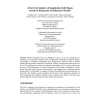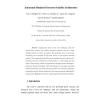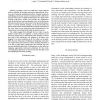500 search results - page 8 / 100 » Humans in the Process: Architectural Implications |
FC
2005
Springer
14 years 2 months ago
2005
Springer
We suggest a general paradigm of using large-scale distributed computation to solve difficult problems, but where humans can act as agents and provide candidate solutions. We are e...
ATAL
2004
Springer
14 years 2 months ago
2004
Springer
We describe the initial steps in developing an agentbased cognitive architecture designed to support psychologically plausible human variability. The new architecture, COJACK, is ...
EMISA
2009
Springer
14 years 3 months ago
2009
Springer
Abstract: Modern enterprises face the challenge to survive in an ever changing environment. One commonly accepted means to address this challenge and further enhance survivability ...
BPM
2007
Springer
14 years 3 months ago
2007
Springer
Organizations have to face new challenges, hold new opportunities, conquer and maintain important customers and get a better strategic position as faster as possible. The principle...
ROMAN
2007
IEEE
14 years 3 months ago
2007
IEEE
—Teaching a robot new skills may require that the teacher scaffolds the teaching experience appropriately. However, due to inherent assumptions made by a human teacher the scaffo...



